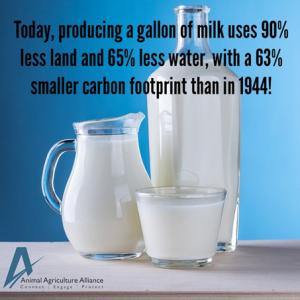Did you know that the dairy industry pledges to achieve carbon neutrality, optimized water usage, and improved water quality by the year 2050? Cool, huh? But how do they plan on doing that?
To find out, I interviewed Karen Scanlon from the trade association Dairy Management Inc. to learn more. Scanlon is the Senior Vice President of Sustainability who helps lead the initiatives and partnerships.
Today’s farmers do more with less (more output on less land; more acres tended with less labor; etc.). Although reducing environmental impact has always been a big focus for agriculture, many would say that the industry overall needs to do a better job of sharing the story behind that. As one example, researched published in the Journal of Animal Science shows the carbon footprint of a glass of milk has been reduced by 19 percent from 2007 to 2017. An earlier report also found the environmental footprint to produce a gallon of milk has shrunk significantly between 1944 and 2007 — using 90 percent less land, 65 percent less water, 63 percent smaller carbon footprint per gallon.

Even more recently, data from researchers at Virginia Tech showed the particularly small footprint of dairy cows on greenhouse gases, particularly in comparison to the supply of nutrients for humans that these animals supply. The removal of dairy cows from the United States agricultural industry would reduce greenhouse emissions by only about 0.7 percent, while the impact on human health would be much more significant.
The dairy initiatives put forth by the Innovation Center for U.S. Dairy (a checkoff-funded center whose board members represent over 60 percent of milk production) wanted to take it a step further by setting and developing these collective industry wide environmental goals and committing to report progress every five years. The two overarching strategies include both on-farm strategies as well as improvements within the plant and processing sector.
On-farm improvements include, but are not limited to, practices that help reduce environmental impacts and improve economic viability in four areas of dairy farms:
- Feed Production. Net zero field to farm, where is the feed grown?
- Cow care and efficiency.
- On farm energy-efficiency and renewable energy.
- Manure handling and nutrient management.
Simultaneously, dairy plants and processor strategies include evaluating:
- Improving water use within plants,
- Managing facility waste even better,
- Implementing better materials and packaging, and
- Reducing ghg emissions from processing facilities.
How do they plan on implementing such big goals? Well, it’s no secret the dairy industry is a small world where everyone kinda knows everyone. Six founding partners joined together to form the Net Zero Initiatives to help achieve these goals: DMI, the National Milk Producers Federation, the U.S. Dairy Export Council, International Dairy Foods Association, and Newtrient. They want to knock down barriers, improve data and efficiencies, make reducing environmental impact more affordable, develop manure-based products, have more water and carbon trade benefits, and so much more. They also partner with corporations such as Starbucks and Nestle through the NZI.
Farmers need access to strong support and small group conversation is just one way to continue building on environmental improvements. Boards, farmer groups, virtual presentations, network through state and regional checkoff programs, co-ops and processors, and dairy trade organizations — the list goes on. The three core areas of work to track progress are:
- The science team — research, data, analytics, and modeling to help measure the changes.
- Viability study — farmers and funding for an aspiring 2021 “Dairy Scale for Good” study, which would be a comprehensive analysis of the on-farm four core areas of focus listed above to develop manure-based products and market solutions for communities outside of dairy.
- Collective impact — access and support to enable scaling opportunities for farms of all sizes.
The takeaway here is that the dairy industry is building on commitment that their farmers already have. Leaders behind these dairy initiatives believe that by following these principles, they can drive change through research and action. Pilot studies and preliminary analysis are underway, while building infrastructure to showcase the benefit and accessibility can continue to bring this comprehensive program to life. Agriculture is a beneficial driver for the environment and we have to do our best to improve perceptions of this. Dairy is part of the solution and an uplifting key partner in combatting climate change.
Michelle Miller, the Farm Babe, is a farmer, public speaker and writer who has worked for years with row crops, beef cattle, and sheep. She believes education is key in bridging the gap between farmers and consumers.



